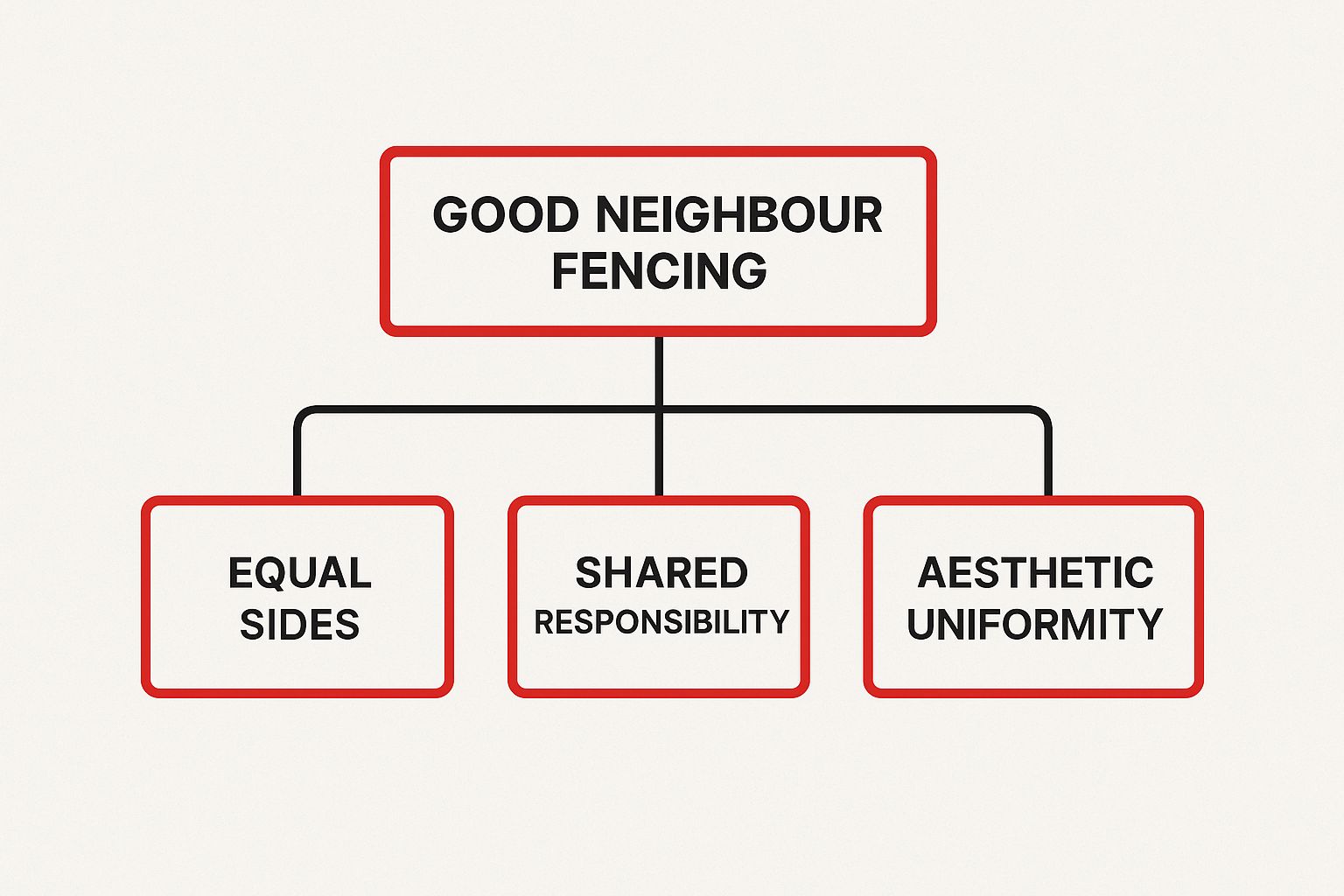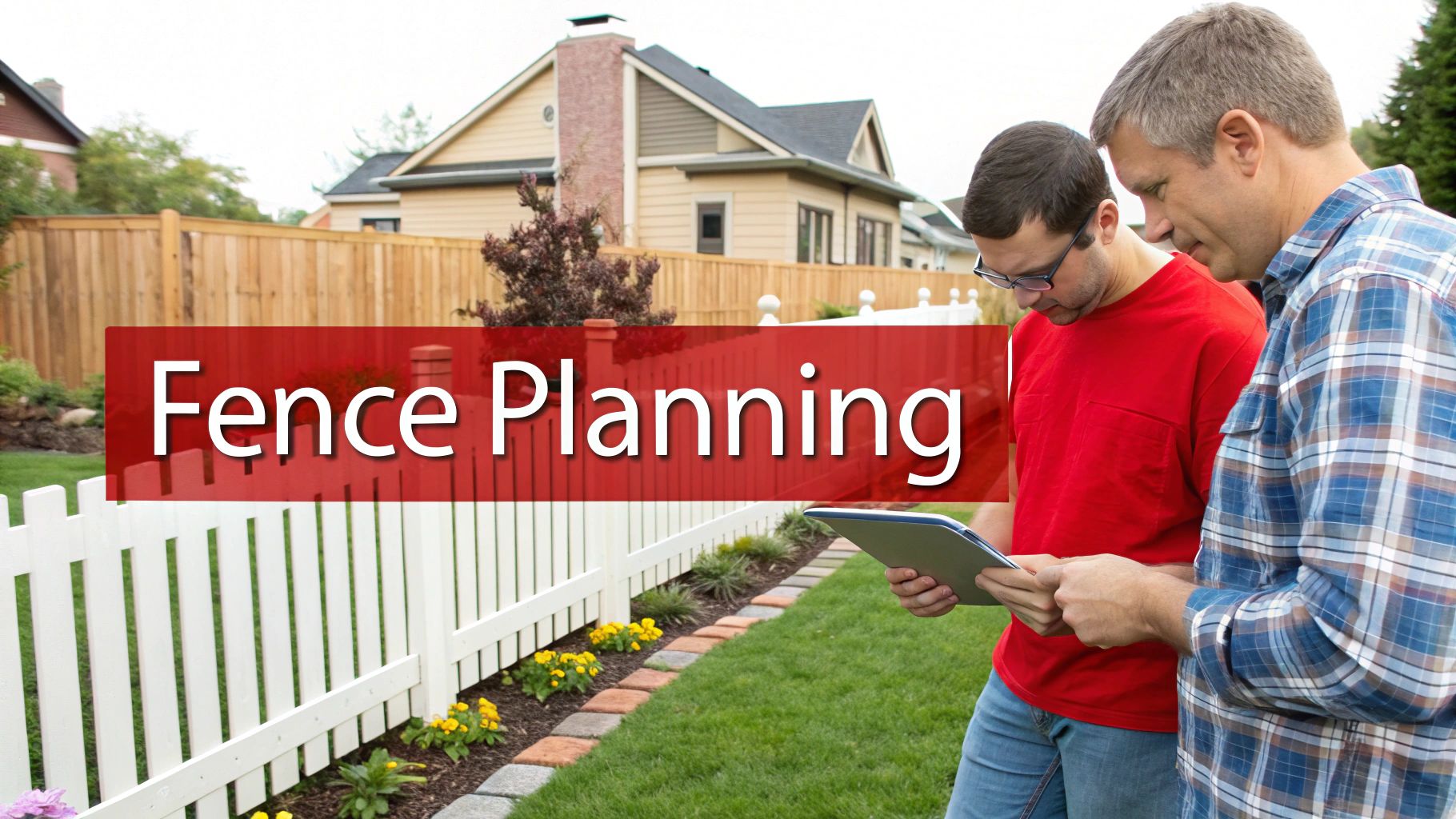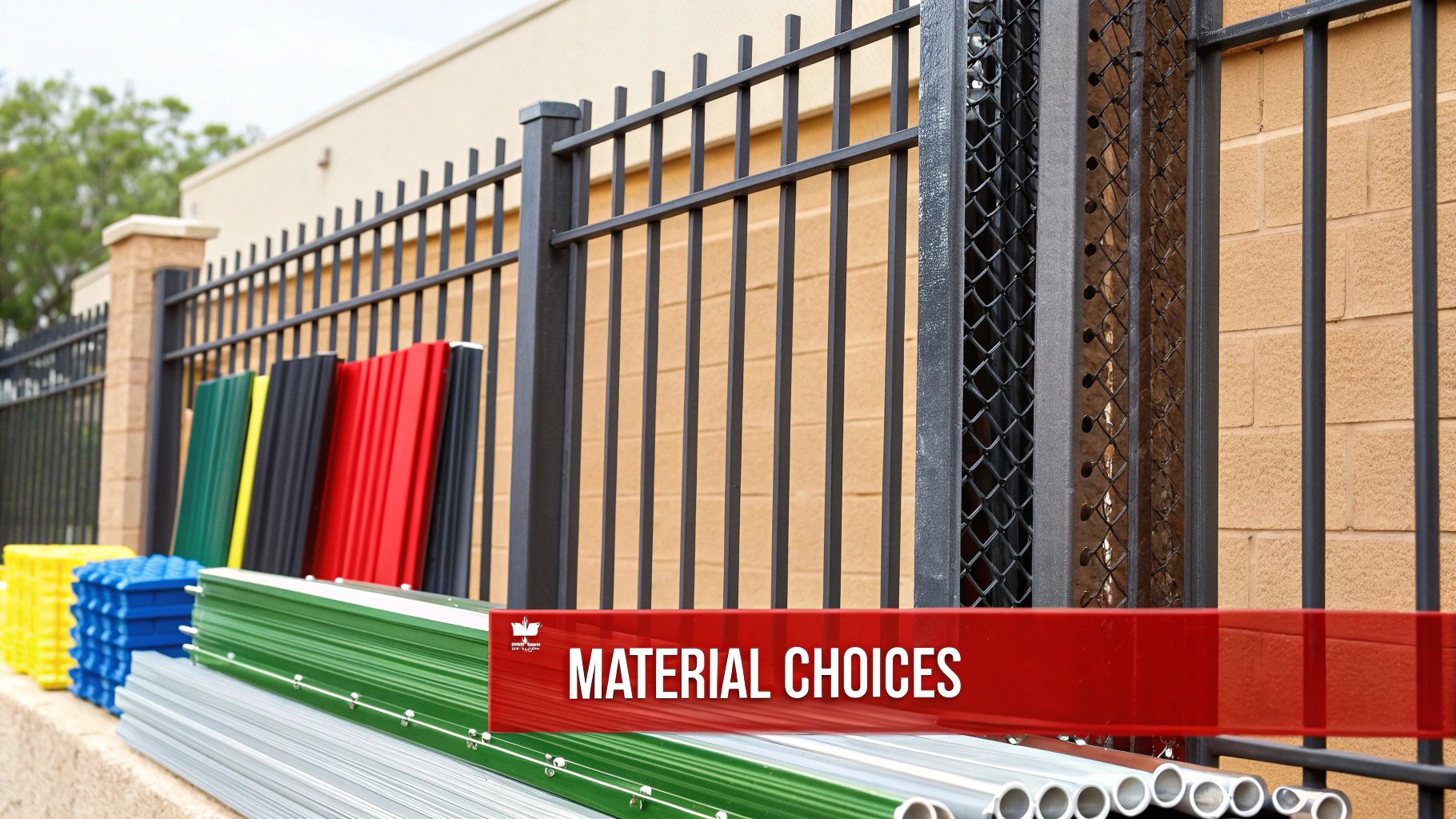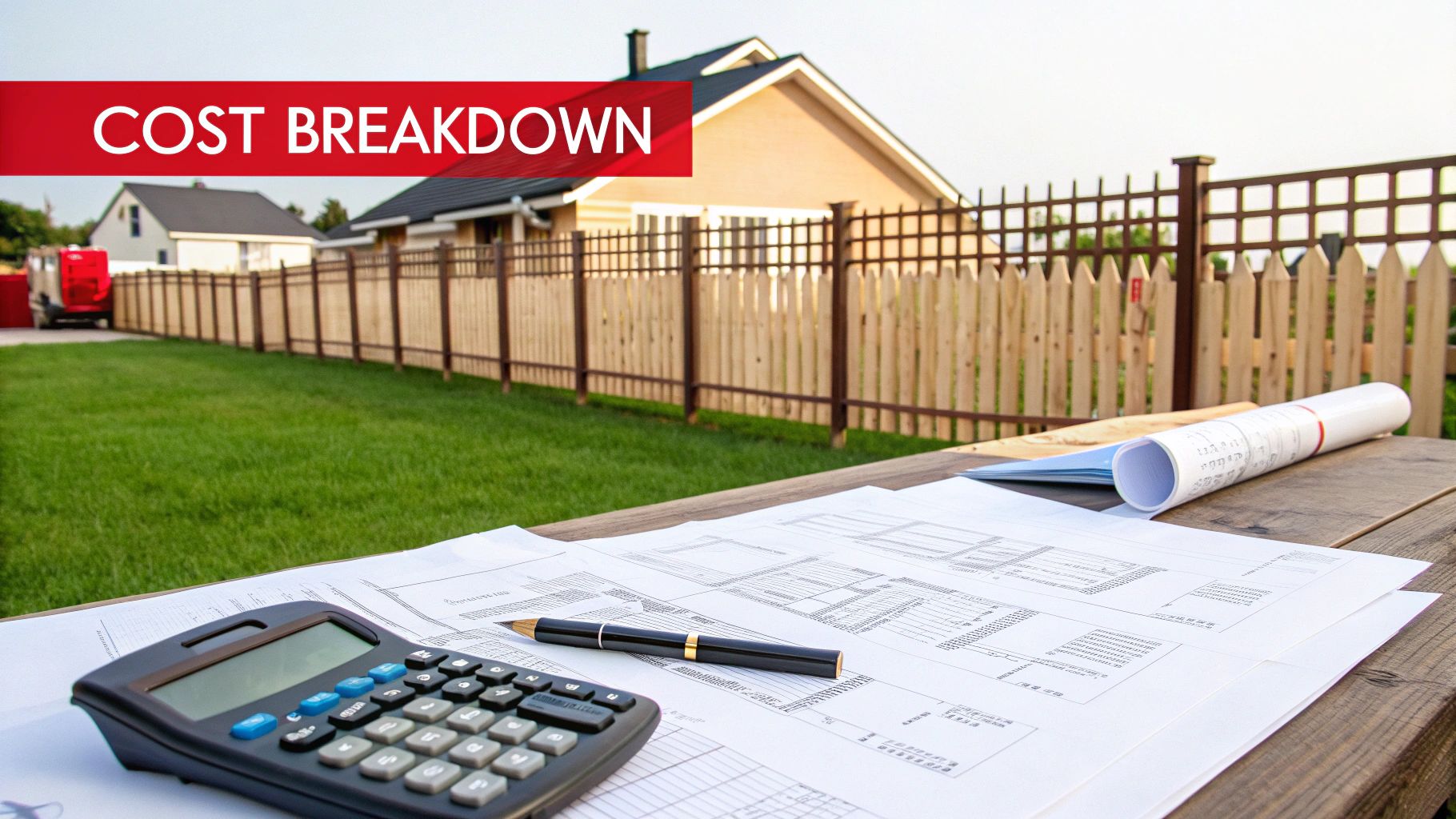A good neighbour fence is a simple but brilliant solution to an age-old problem: the boundary fence that looks great from one side but leaves the other homeowner staring at ugly posts and rails. The core idea is that the fence is designed to look identical from both sides, ensuring a clean, consistent finish for everyone.
This shared approach isn't just about looks; it sidesteps common disputes before they can even start, making it a popular choice for keeping the peace between properties.
Think of a good neighbour fence as the perfect diplomatic solution for your property line. It’s a concept that has become a staple in suburbs right across Australia because it’s built on fairness.
In the past, traditional fencing meant one person got the "good side"—the clean, smooth face of the panels—while the other was stuck with the "bad side," the structural frame of posts and rails. This imbalance was a frequent source of friction.
Good neighbour fencing flips this on its head. It uses a clever panel system where the sheets slot neatly between the posts. The result? A seamless, identical finish, no matter which side of the boundary you're on. It’s a modern design that’s about more than just good looks; it’s about mutual respect and shared benefit.
At its heart, this fencing style is guided by three simple ideas that create a better boundary for you and your neighbour.
This infographic neatly sums up how these principles come together to form the basis of a good neighbour fence.

As you can see, these pillars support the whole concept. They turn a simple boundary marker into a symbol of cooperation, setting the stage for a hassle-free fencing project right from the get-go.
When you decide to put up a fence on a shared property line, it's about more than just picking a style you like. Fencing projects are governed by specific laws that change from state to state, all designed to keep things fair and avoid arguments with your neighbours. Getting your head around these rules is the first step to a smooth project that keeps everyone happy.
These laws provide a clear roadmap for everything from how costs are shared to how high the fence can be. They make sure no one gets stuck with the entire bill for a standard boundary fence and that the final result is reasonable for the area. Nailing this part early saves you a world of time, money, and stress down the line.
Across Australia, fencing laws are often built around the concept of a “sufficient fence.” This is a legal term, but it basically means a fence that’s considered good enough for its purpose in your specific neighbourhood. What counts as 'sufficient' can be completely different depending on where you live.
For example, in a suburban Sydney street, a 1.8-metre steel fence is pretty standard and would likely be considered sufficient. Head out to a rural property, and a simple post-and-wire fence might be all that's required. The law generally says neighbours must share the cost of building or repairing a fence up to this basic standard.
If you've got your heart set on something fancier—like a taller fence for more privacy or one made from premium materials—you'll typically have to cover the extra cost yourself, unless your neighbour loves the idea and agrees to chip in.
It's super important to know that there's no single, nationwide rulebook for fencing. Every state and territory has its own legislation, which can dictate everything from height limits to the proper way to notify your neighbour.
Australian states and territories impose specific regulations influencing good neighbour fencing, especially when it comes to height. In New South Wales, for instance, residential boundary fences are typically capped at 1.8 metres high unless you get a special permit. Over in Victoria, you can usually go up to 2 metres, but anything taller needs council approval. Queensland's laws focus more on getting an agreement with your neighbour about what's adequate, with typical fence heights ranging from 0.5 to 1.8 metres. These differences show just how vital it is to check your local council's rules before you start drawing up plans.
A classic rookie error is assuming the rules are the same everywhere. Always, always check with your local council for the specific requirements that apply to your property before you lock in any plans or buy materials. That one phone call can save you from some very expensive mistakes.
When you're sorting out your boundary, it's also worth thinking about related council rules, like understanding council rules for automatic gates, which often involve similar legal hurdles.
Before a single post hole is dug, the law says you need to follow a formal process. You can't just build the fence and then slide an invoice under your neighbour's door. The first official step is to give them a “fencing notice.”
This isn't just a casual chat over the fence; it's a formal written document that lays out your proposal. It needs to include key details, such as:
This notice gives your neighbour a fair chance to look over the proposal and respond. They usually have a set timeframe (often 30 days) to either agree or raise any concerns. Think of it as the official starting point for your discussion, and it's a legal must-have if you end up needing to resolve a dispute later on. Keeping everything in writing protects both of you and ensures you're on the same page from day one.

A sturdy, stylish fence starts long before the first post hole is dug. The single most important step in any good neighbour fencing project is a simple, friendly chat. Getting on the same page from the beginning turns a potentially awkward job into a smooth, cooperative effort. It’s a great way to build goodwill and a great fence.
Starting the conversation doesn't have to be a big deal. A casual "G'day" over the existing fence or a knock on the door is all it takes. You could try something like, "Hey, I've been thinking about replacing the old fence between our places and wanted to see what you thought." It's an open-ended approach that invites your neighbour into the process, rather than making them feel like they're being told what to do.
Once you've both agreed it's a go, the next step is to work through the details together. Putting together a shared checklist is a fantastic way to make sure nothing gets missed and that both of you have a say in the final outcome. It keeps everything transparent and fair.
Your checklist should cover a few key points to get the ball rolling:
With a plan locked in, it’s time to get some quotes. A good rule of thumb is to gather at least two or three written quotes from reputable installers or suppliers. When you go directly to a supplier like Super Rack, you often find better pricing because you're cutting out the middleman. This means you can get your hands on top-quality materials for less.
Sit down and review the quotes together. Make sure they cover everything—materials, labour, and the removal of the old fence. Once you’ve picked one, it’s smart to get your agreement down in writing.
A simple written agreement is your best friend. It doesn’t need to be a complex legal document—just a clear summary of the agreed-upon fence style, height, colour, total cost, each neighbour's share (usually 50/50), and the chosen contractor. Make sure you both sign it and keep a copy.
Before any work kicks off, you absolutely must know where the property line is. Never, ever guess. The only way to be certain is to check your property’s survey plan.
If the survey pegs are gone or the line is fuzzy, you’ll need to hire a licensed surveyor to mark it out professionally. This is a shared cost and a non-negotiable step to prevent any headaches over land ownership down the track.
As you're clearing the area for the new fence line, you might run into old tree stumps. Knowing your stump removal solutions can be handy for getting the site prepped and ready.
By working through these steps together, you’re doing more than just building a fence; you’re strengthening your relationship with your neighbour. For expert advice on choosing the right materials, our team at Super Rack is always here to help.

The materials you pick for your good neighbour fencing do more than just set the look. They're the difference between a fence that lasts and one that causes headaches down the line, affecting durability, maintenance, and your wallet.
While timber fences used to be everywhere, modern steel has well and truly become the gold standard for Aussie boundary fences. And for good reason. It’s a practical investment that gives both you and your neighbour genuine peace of mind.
When you’re splitting the cost of a fence, the last thing anyone wants is to be paying for repairs in a few years. This is where steel really proves its worth. Unlike timber, which can warp, rot, or fall victim to termites, a quality steel fence is built to stand up to the harsh Australian climate.
That resilience means you’re not facing costly fixes or a full replacement anytime soon. It’s a classic "set and forget" solution that holds its appearance and value, making it a fair and sensible choice for both homes.
Plus, the upkeep is minimal. A steel fence doesn't need the constant painting, staining, or sealing that a timber fence requires just to survive. A quick hose-down once or twice a year is usually all it takes to keep it looking sharp.
Modern steel fencing isn’t a one-size-fits-all product. You and your neighbour can choose from a range of profiles and styles to find a look that complements both your homes, whether they're contemporary builds or more traditional.
Some of the most common profiles include:
The style you land on will really shape the feel of your outdoor space, so it’s a great idea to chat through the options with your neighbour and find a profile you both love.
Because a good neighbour fence looks identical from both sides, agreeing on a colour is a must. Most suppliers offer a palette of modern, neutral colours that are designed to blend in with different home designs and garden landscapes.
Popular choices tend to be shades of grey, cream, and deep greens. These tones are versatile and work well with both brick and rendered houses.
Choosing a neutral colour is the safest bet for ensuring long-term satisfaction for both parties. It avoids trends that might date quickly and provides a subtle backdrop that allows landscaping and other features to stand out.
Not all steel fencing is created equal. The quality of the steel and its protective coatings makes a massive difference in how long your fence will actually last. Investing in premium-grade materials from a trusted supplier like Super Rack is essential.
Superior quality steel is engineered to resist corrosion, fading, and denting, ensuring your fence remains a valuable asset for decades.
At Super Rack, we understand that a fence is a significant investment. That's why we offer competitively priced, high-quality steel fence panels and mesh built to endure Australian conditions. With our fast, nationwide delivery, you can get the best materials for your project without delay, backed by expert advice to help you make the right choice. A quality fence isn't just a boundary; it’s a lasting improvement to your home.

Let's talk money. It’s a vital part of any fencing project, and getting a handle on the costs early helps you and your neighbour budget properly and avoid any awkward surprises later. A good neighbour fencing project is a shared investment, after all, so a transparent breakdown of the numbers is the key to keeping things friendly and straightforward.
The cost is almost always quoted per linear metre. This makes it simple to get a rough total for your boundary line. That per-metre price should cover the basics—panels, posts, and rails—but it’s always a good idea to double-check exactly what’s included in any quote you get.
Across Australia, you can expect the supply and installation of a standard steel good neighbour fence to land somewhere between $100 to $200 AUD per linear metre.
Where your project falls in that range depends on a few things. A standard 1.8-metre-high fence will be cheaper than a taller 2.1-metre one. Likewise, premium colours or a heavier grade of steel will nudge the price towards the higher end of the scale.
A few key factors will move the needle on your final quote:
One of the biggest forks in the road for your budget is deciding whether to tackle the job yourself or bring in the pros.
DIY Installation: If you’re handy with the tools, going the DIY route can slash your costs by cutting out labour entirely. It’s a very doable project for a capable DIYer. The trick is to source top-quality materials directly from a supplier—that way, you know your hard work will result in a fence that stands the test of time.
Professional Installation: Hiring a fencer adds labour to the bill, but it buys you convenience and peace of mind. A pro will get the job done fast, making sure the fence is installed correctly and looks sharp. Just be sure to get a couple of quotes to compare prices and check out their previous work.
Here’s a smart way to keep your good neighbour fencing budget in check: cut out the middleman.
When you buy materials directly from a supplier like Super Rack, you skip the markup that installers often add to their quotes. This move puts you in control of your spending and ensures you get high-quality materials without the inflated price tag. It's a great way to get your hands on premium options, especially if you're looking for extra security with something like a 1.8m high steel spear top security fencing panel.
With fast, nationwide delivery, Super Rack makes it easy to get everything you need sent straight to your door, whether you’re installing it yourself or just supplying the materials to your chosen contractor.
Getting your **good neighbour fencing** built is a huge step, but the job doesn’t end when the last panel clicks into place. A solid installation and a tiny bit of ongoing care are the secrets to making sure your shared investment stands strong and looks sharp for decades.
It doesn’t matter if you're a keen DIYer or hiring a pro—getting the installation right from day one is everything. A wonky job can lead to leaning posts or rattling panels, creating headaches that were completely avoidable.
For those ready to get on the tools, a great result comes down to good prep and a sharp eye for detail. It’s a rewarding project that can save you a fair bit on labour, as long as you nail the fundamentals.
Taking your time with these basics will pay off in a big way, leaving you with a professional-looking fence that both you and your neighbour can be proud of.
If you’d rather hand the job over to the experts, picking the right contractor is crucial. A good installer not only gets the work done efficiently but will also stand by their work, which gives you valuable peace of mind.
When you're checking out potential installers, look for a solid track record. Ask to see photos of their previous good neighbour fencing projects and jump online to read reviews. Make sure they're insured and that they provide a clear, detailed quote that breaks down all the costs, so there are no nasty surprises.
The real sign of a quality installer is their precision. Look closely at the small details in their past work—are the gaps between panels consistent? Are the screw lines neat and tidy? That level of care is what separates an average job from an excellent one.
One of the best things about a modern steel fence is how little looking after it needs. Forget spending your weekends sanding, painting, or staining like you would with timber.
To keep your fence looking brand new, just give it a good hose-down a couple of times a year. This will wash away any build-up of dirt, dust, and cobwebs. If you’ve got some stubborn grime, a bit of mild soap and a soft-bristled brush will sort it out. That's it. That minimal effort is all it takes to protect the finish and keep your fence looking clean and modern for years to come.
To wrap things up, let's tackle some of the questions we hear all the time from homeowners about good neighbour fencing. Getting these final details clear will help make sure your project gets over the line without any headaches.
In Australia, the law is pretty clear on this. For a standard, 'sufficient' boundary fence, the cost is typically split 50/50 between you and your neighbour.
But what if you want something a bit fancier than the standard? Say, a taller fence for extra privacy or a premium finish. In that case, you're usually on the hook for the extra cost above the 50% share for a basic fence. It's always a good idea to get any cost-sharing agreement down in writing before a single post goes in the ground.
This is where things can get tricky. If your neighbour isn't willing to chip in, you can't just build the fence and send them an invoice. There’s a formal process you need to follow, starting with serving them a 'fencing notice'.
This is an official document that lays out the proposed work, the quotes you've received, and the costs to be shared. If they still won't play ball, your next move is usually to seek a legally binding fencing order from a local court or tribunal. Your local council is the best place to ask for guidance on the exact steps for your area.
Because a good neighbour fence is designed to look the same from both yards, picking a colour has to be a team decision. The best way forward is to chat about the available options and land on a neutral colour that works for both properties.
Making a call on your own is a surefire way to create friction. If you're struggling to find common ground, choosing a popular and versatile colour like a slate grey or a classic cream is often the easiest path to keeping everyone happy.
When it comes to the boundary line, never guess. The only source of truth is your official property survey plan. An assumption here can quickly turn into a costly and stressful dispute down the track.
If you can't find your survey pegs or the property documents aren't clear, you’ll need to hire a licensed surveyor to mark the boundary professionally. It’s a non-negotiable step to avoid building the fence in the wrong spot, which can open up a whole can of legal worms. The cost for a surveyor is also usually shared between neighbours.
Ready to build a fence that strengthens boundaries and neighbourly bonds? At Super Rack, we provide top-quality fencing solutions at competitive prices, with expert advice and fast, nationwide delivery.
Explore our range of durable fencing options at https://www.superrack.com.au.
4000 to 4182
4186 to 4207
4300 to 4305
3000 To 3096
3098 To 3112
3114 To 3138
3140 To 3157
3161 To 3198
3200 To 3207
Let's connect